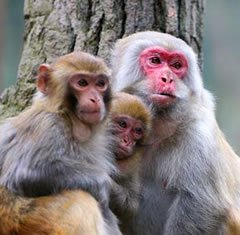Zhangjiajie National Park, covering over 50 square miles, is the first national forest park of China and the highlight of the gorgeous Wulingyuan Scenic Area. The park was originally a state-run tree farm, which was founded in 1958, and then was officially approved to be a national-level forest park in 1982. Featuring the vast forest of peculiar sandstone peaks, the park was added to the World Natural Heritage list in December of 1992 and became a member of the first World Geoparks promulgated by the UNESCO in 2004. It covers three natural reserves, and contains over 500 tree species, including the Dawn Redwood, believed extinct until it was re-identified in 1948. There are also giant salamanders, rhesus monkeys, and many bird types.
 ANIMAL LIFE
ANIMAL LIFE
The complicated topography, steep cliffs, and deep gullies, as well as the heavy rainfall and dense forests, provide animals with an excellent living environment. There are 116 species of vertebrates belonging to 50 families that have been identified in the park. The largest animal population in the park is the rhesus monkey, which numbers more than 3,000 and can be found everywhere in the park. Macaque monkeys are found in Wulingyuan; they playfully jump from tree to tree. Unafraid of humans, they are like naughty children but will befriend the tourist who offers them candy or chocolates. They are classified into three groups according to fur color: blue macaque, yellow macaque and golden macaque. Hundreds live in the Zhangjiajie forest park.
The Chinese giant salamander can be found in some streams and pools. They are also known as “baby fish” because they give a sound like a crying baby, and have four legs similar to a baby’s arms. Many giant salamanders inhabit cool, clean streams and ponds, relying on small fish, crabs, shrimps and frogs for food. The giant salamander was chosen to be the mascot of Zhangjiajie City at the 2007 Zhangjiajie International Forest Conservation Festival.
Pangolins, or scaly anteaters, dig holes in their high mountain habitats. At about half a meter long, they have a hard carapace, long tongue, sharp claw, and small legs. They use their well-developed sense of smell to find insects. They tear open anthills or termite mounds with their powerful front claws and probe deep into them with their very long tongues. They are nocturnal mammals and spend most of the daytime sleeping, curled up in a ball.
BIRDS
Carrying water birds, a tate-protected animal, are distinctive, with their colorful feathers. Each bird has a special bag-like organ for carrying water. These birds usually live on mountaintops and will fly to streams or rivers to drink water when thirsty. After drinking almost one kilogram of water (a little over 2 pounds of water), they will use their bag to store water for later days.
TREES
Among scarce plants, the Dove Tree (also known as the Handkerchief Tree) is perhaps the most famous. It is regarded as a “living fossil”, having survived during the Glacier of the Fourth Period (2.5 million years ago). Botanists were unable to trace its origin until the middle of the 19th century. The Dove Tree, a medium-sized tree very suimilar to a dogwood tree, is best known for its flowers. These form a tight cluster about 1–2 cm across, reddish in colour. Each flower head with a pair of large (12–25 cm), pure white bracts at the base performing the function of petals. These hang in long rows beneath the level branches. The flowers are at their best in late May. On a breezy day, the bracts flutter in the wind like white doves or pinched handkerchiefs, hence the English names for this tree.
In the Badagongshan National Nature Reserve located in Sangzhi County, there exists a small valley replete with over 10,000 wild dove trees. “Dove Tree Valley” as it is known, boasts the world’s biggest “King Dove Tree” — it stands 100 feet tall.
PLANTS AND FLOWERS
Lobster flowers (named after their red, yellow or purple shrimp-shaped petals) usually grow in humid and shady places. In full bloom along the bank of Golden Whip Stream (located in the east of Zhangjiajie National Forest Park), they provide a stunningly picturesque scene.
Wulingyuan abounds with Chinese chestnut trees. The Chinese Chestnut is a medium-sized tree, maturing to heights of about 40-60 feet with a 40 foot spread. One Chinese Chestnut tree can provide up to 50 pounds of large meaty nuts that are equally sweet and nutritious. You are ready to collect your delectable crop of nuts when the decorative barbed capsules (that look like hedgehogs) begin to crack open. Care must be taken when picking them up, as they are very prickly.
Tangerines have been cultivated for over 3,000 years in China and usually grow in Wulingyuan or Jiangya, and are a specialty of Zhangjiajie. Tangerines are smaller than most oranges, and are usually much easier to peel and to split into segments. The taste is often less sour, or tart, than that of an orange. While less tart, tangerines are considered to be sweeter than oranges. Ripe in autumn, they look beautiful, and provide a wonderful flavor.
